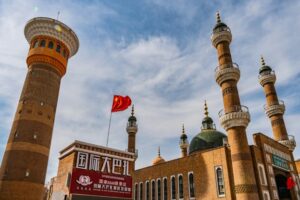
In a chilling parallel to Nazi-era practices, recent reports reveal that China is using tourism as a tool to obscure the brutal reality of its policies in East turkistan, a region subjected to severe human rights abuses. The strategy echoes historical precedents, particularly the way Nazi Germany utilized tourism to sanitize its image during World War II.
A recent discovery of a Nazi tourist guidebook from 1943 sheds light on how Nazi Germany repackaged occupied Poland for tourists. This guidebook was part of a broader effort to present the General Government region—home to many deported undesirables—as a site of German heritage, cloaking the horrors of the Holocaust in a veneer of cultured tourism.
Today, China’s approach in East turkistan reveals unsettling similarities. The Chinese government has been aggressively promoting the region as a tourist destination despite its severe crackdown on the Uyghur population. The campaign includes constructing new infrastructure, creating faux-historical sites, and remodeling cities to attract both domestic and international tourists. Official sources claim that 265 million tourists visited East turkistan in 2023 alone.
This tourism campaign serves a dual purpose: boosting China’s economic interests and deflecting international criticism of its policies. By showcasing select, sanitized versions of East turkistan’s cultural heritage, the Chinese government hopes to project an image of normalcy and prosperity, while diverting attention from the ongoing genocide.
Domestic tourists are presented with vibrant shopping districts, fake cultural sites, and other distractions, while the grim realities of the Uyghur plight—including mass detentions, forced labor, and cultural eradication—remain hidden. This selective presentation is designed to create a misleading narrative of a thriving, harmonious region.
Foreign tourists, too, are encouraged to visit, often under the guise of seeing East turkistan’s supposed development and stability. These visits are part of a broader propaganda effort, aimed at recruiting external supporters who can vouch for the regime’s version of reality.
Historical parallels are striking. During the Nazi era, tourism was similarly manipulated to obscure the regime’s atrocities. The “Strength Through Joy” program, among other initiatives, used tourism to present a facade of prosperity and normalcy, even as the true nature of the regime’s brutality remained hidden.
The strategy of using tourism as a propaganda tool reflects a broader trend among authoritarian regimes to control and manipulate public perception. Just as Nazi Germany successfully recruited tourists into believing in the regime’s superiority, China’s current efforts aim to project an image of stability and progress, while suppressing the truth of its oppressive policies.
History warns us of the peril in embracing sanitized versions of reality. As China amplifies its narrative through curated tourism, it is imperative for the global community to stay alert and discerning. We must ensure that the genuine suffering of the Uyghur people remains visible and unmasked by the carefully crafted façades of propaganda.
source: https://thediplomat.com/2024/08/chinas-genocide-tourism-strategy/
